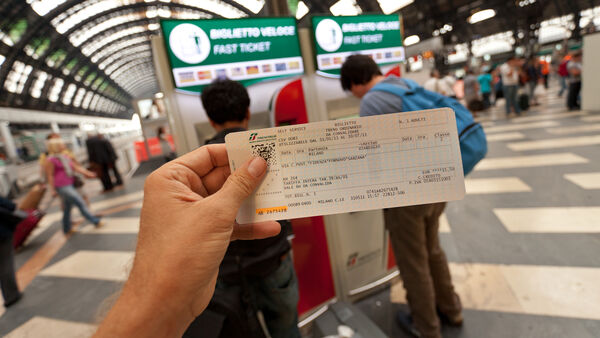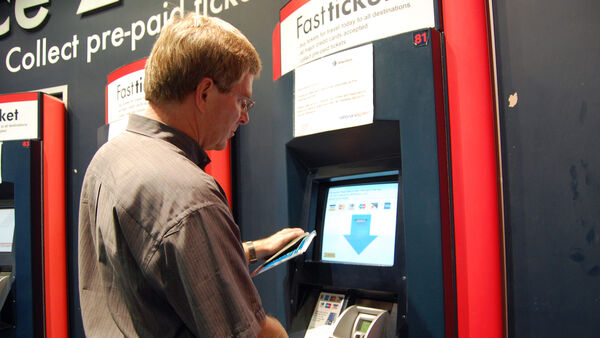Buying European Train Tickets


 Point-to-Point Tickets
Point-to-Point Tickets
By Rick Steves
While a rail pass is often the smart way to ride the rails in Europe, sometimes it makes sense to purchase individual train tickets between specific destinations (either instead of, or in addition to, a rail pass — see my tips for figuring out whether a pass pencils out for your trip).
Unlike rail passes, it's generally easy to buy point-to-point train tickets right at the station (whereas most rail passes aren't widely available in Europe). But it can be smart to buy in advance for certain trains and destinations, especially if your dates are set and you don't want to risk a specific train journey selling out, or if you're hoping to land an advance-purchase discount.
With a valid rail pass, you just hop on any covered train that doesn't require reservations. But even unreserved point-to-point tickets have some flexibility, since you can still make any number of stops and connections along the most direct route between the starting and ending stations printed on your ticket (within a single country your trip usually just has to be completed within the same calendar day — or within a few hours in Italy; for many international point-to-point tickets you have four days to complete the journey).
Where to Get Train Tickets
You have three main options for buying point-to-point tickets: through a US-based retailer before leaving home (we even sell them right here), through the website of one of Europe's national railways, and in person at Europe's train stations (and at some European travel agencies). For big discounts, buy tickets up to three months ahead (just note that these tickets are nonrefundable and nonchangeable).
Through a US Retailer
The easiest way to get train tickets online is to buy them through ricksteves.com (after all, you're already here!). Virtually all US-based websites and travel agents sell European train tickets for the exact same prices you'll find here.
And rail-pass holders who still need tickets and/or seat reservations on certain trains — most notably Eurostar trains between Paris and London or Brussels, and any TGV — are smart to get their passholder-fare tickets well in advance.
On National-Railway Websites
Many European national rail companies allow customers to buy tickets online at the going European price (usually for faster classes of trains for which reservations are required, or at least recommended).
If you're looking for the cheapest possible ticket between A and B — especially if A and B are in the same country — this is the way to go. Advance tickets can be an especially smart buy for popular high-speed trains (such as France's TGV trains and Italy's Le Frecce trains), which frequently sell out.
Not all national-railway sites are created equal: While many are fairly easy to navigate (see my tips for using the well-designed British, French, German, Irish, Italian, Swedish, and Swiss railway sites), some are difficult for foreigners to use (notably the Austrian, Norwegian, and Spanish railway sites; PayPal solves some credit-card difficulties).
Your ticket may be a QR code or barcode on your phone, an emailed confirmation code redeemable at the station (in the same country that operates the website you bought it on), or a print-at-home document. Online tickets are valid for a specific date and time and have strict refund restrictions, so read the fine print carefully.
In Europe
Once in Europe, you can simply get tickets at the station (or on your phone), usually without much fuss, either on your day of travel or in advance (see my tips for buying tickets in European train stations). This is the best option if you'd prefer to keep your itinerary more spontaneous. You can even get tickets for trains in another country: For example, if your trip starts in Paris, you can buy your Berlin-to-Prague ticket at any Parisian train station. Tickets bought at train-station windows tend to be easier to change (or have refunded) than tickets bought online.
In some cities you can avoid trekking to the train station by visiting a neighborhood travel agency or branch office of the national railroad. This convenience may come with a fee, but if the agency is easier for you to get to than the train station, buying tickets there can save lots of time and hassle (and travel agents may have more time and English-language skills than the people behind the train-station counter).
Ticket Prices
European train fares are based primarily on the distance traveled. Each country has its own "euros per kilometer" formula, though the type of train also affects the price (logically, slower trains are usually cheaper than faster ones). For faster classes of trains, however, many European rail companies have moved to a dynamic pricing system — similar to how airfares work — in which a fare can vary depending on demand, restrictions, and how early you purchase.
The quickest way to get a rough idea of what you'd pay for any given train trip in Europe is to check my cost-estimate maps.
Scoring Ticket Discounts
If you're buying point-to-point tickets, be aware of the ways you can qualify for a discount (whether buying through a national-railway website or in person). For details, check this site's country-specific rail pages for any countries you're planning to visit.
Advance purchase (a week to several months in advance) can save you significant money in many countries (most notably Austria, Britain, Finland, France, Germany, Italy, Spain, and Sweden), especially for faster or longer rides. On-sale dates vary by country, route, and time of year, with most starting two to four months in advance of travel, and six months ahead for Germany and the Eurostar Chunnel train. In some areas (such as Switzerland and most eastern countries), advance-purchase deals either don't exist or aren't worth the hassle. In most places, tickets for slower regional or medium-speed trains cost the same whether they're bought two months or two minutes before the train leaves.
Round-trip tickets can be cheaper than two one-way tickets in some countries (Britain, Ireland, and Spain; sometimes in combination with advance purchase). In Britain, a "day return" (round-trip in a single day) can be only a little bit more expensive than a single one-way ticket.
Children get ticket discounts in most of Europe (typically about 50 percent off for ages 4–11, sometimes free with an adult). Whether you're traveling with tickets or a rail pass, kids under 4 always travel free on your lap (though if there's an empty seat, feel free to use it).
"Youths" (usually age 12–25, depending on the country) can buy discount cards in Austria, Belgium, Britain, France, Germany, and Italy.
Seniors can find a few ticket deals, most of which require a discount card purchased in Europe (discounts start between ages 60 and 67).
Off-peak travel (such as midday or midweek) can be cheaper than peak-time journeys (mainly in Britain and France).

